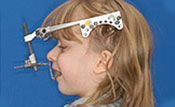Distraction Osteogenesis
What is distraction osteogenesis?
Distraction osteogenesis is a way to make a longer bone out of a shorter one.
After a bone is cut during surgery, a device called a distractor pulls the 2 pieces of bone apart slowly. The slow stretching apart of bone is not painful. Children say it hurts less than braces they wear to straighten teeth.
New bone grows (osteogenesis) to fill the gap. This happens at home after your child leaves the hospital. The process takes a couple of months.
Distraction osteogenesis allows for bigger corrections in bone position than is possible in a single traditional surgery. This improves the results and may reduce the amount of surgery a child needs over their lifetime.
Seattle Children’s is a leader in distraction osteogenesis for craniofacial syndromes. Through research, we have developed a shorter process compared to other hospitals. Our techniques also help prevent scarring on your child’s face.
How does distraction osteogenesis work?
In both distraction osteogenesis and traditional procedures, surgeons make a cut in a bone. A procedure may be called an osteotomy, which means cutting a bone.
- In traditional surgery, the doctor uses bone grafts to lengthen bones. In some cases, a bone is moved and held in its new position with metal plates and screws.
- In distraction osteogenesis, a surgeon attaches a device called a distractor to the cut bone. Sometimes the distractor is placed under the skin. Other times it is attached to a child’s skull and face bones on the outside of their skin.

The type of distractor used depends on the bones that need to grow. The devices are approved by the Food and Drug Administration. All devices are made of a lightweight hypoallergenic metal called titanium.
For midface distraction surgery, the device is usually a U-shaped headframe. The surgeon fastens it around the top of your child’s head and attaches it with special screws called “pins.”
A vertical metal bar attaches to the headframe in front of your child’s forehead. At the level of the mouth, the vertical bar attaches to a horizontal bar that has a turning arm. The surgeon wires the turning arm to a dental splint bonded to the upper teeth.
The headframe has an opening in back. Children say it is not a problem to sleep with the device on.
For lower jaw (mandible) distraction, the devices are smaller. Often they fit under the skin. A small post passes through the skin to adjust the device.
For 2 to 3 weeks after surgery, while your child is at home, a parent or caregiver turns 1 or more screws on the distractor 1 to 2 millimeters a day. This keeps tension on the wires and moves the face bones apart. New bone then grows to fill in the gaps.
Once the bones are in the right position, turning stops. The bones heal in their new positions. This is called consolidation, or the “healing phase.” It lasts 1 to 2 months.
Your child will have to eat soft foods for the entire time the distractor is on. They will need to visit Seattle Children’s often so we can check that the distractor is working properly and decide when to stop turning. At some visits your child will get X-rays of their face. We may need to make small adjustments to the distractor.
When the new bone is strong enough, the distractor is removed during a very short second operation.
What is Seattle Children’s experience with distraction osteogenesis?
We are experienced in treating children of all ages with distraction osteogenesis. Our patients include:
- Newborns who have trouble breathing
- Toddlers whose small jaw requires use of a breathing tube in the windpipe
- Children whose cheekbones and eye sockets don’t give their eyes enough protection
- Teens whose jaws do not line up properly
We tailor treatment to your child’s condition.
To help plan your child’s treatment, our craniofacial plastic surgeon and surgical orthodontist use 3-D imaging and advanced software to build precise maps of your child’s face and skull. 3-D imaging allows our doctors to predict how movement in one part of the face is likely to affect other areas. The software also accounts for expected growth. This helps the surgeons plan exactly how much to move different bones of the face and in which direction.
Shorter process with better results
The processes we developed at Seattle Children’s shortens the distractor time compared to the method at other hospitals.
Our methods help prevent scarring to the face. For example, to connect the upper jaw to the distractor device, the surgeon uses small cuts (incisions) and a custom splint that fits in your child's mouth. We do not place posts in their cheeks, as most other hospitals do. Your child’s hair will soon hide the single scar on the top of their head.
What types of distraction osteogenesis are done at Seattle Children's?
Distraction osteogenesis is an option for many surgeries that move bones in the skull and face into better positions. Our team works together and with you to decide if the best result will be achieved with or without distraction osteogenesis.
Surgeons in our Craniofacial Center use distraction osteogenesis in these procedures:
- Posterior cranial vault distraction to give the brain room to grow
- Monobloc frontofacial advancement to reposition the forehead and midface
- Segmental subcranial distraction to normalize the proportions of the face
- Subcranial rotation distraction to improve the airway and jaw position
- Le Fort I maxillary advancement to correct upper jaws that have not grown properly
- Le Fort III midface advancement to move the middle of the face forward
- Mandible distraction for a lower jaw has not formed properly
Contact Us
Contact the Craniofacial Center at 206-987-2208 for an appointment, a second opinion or more information.